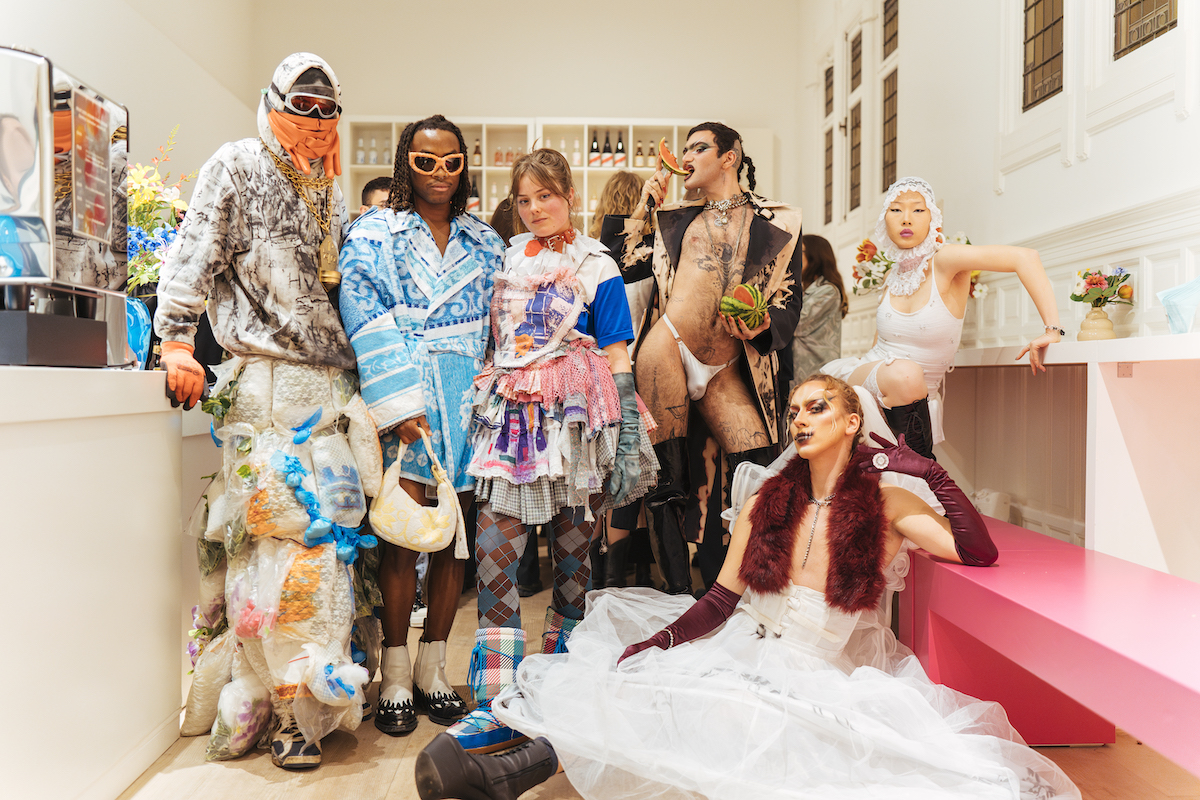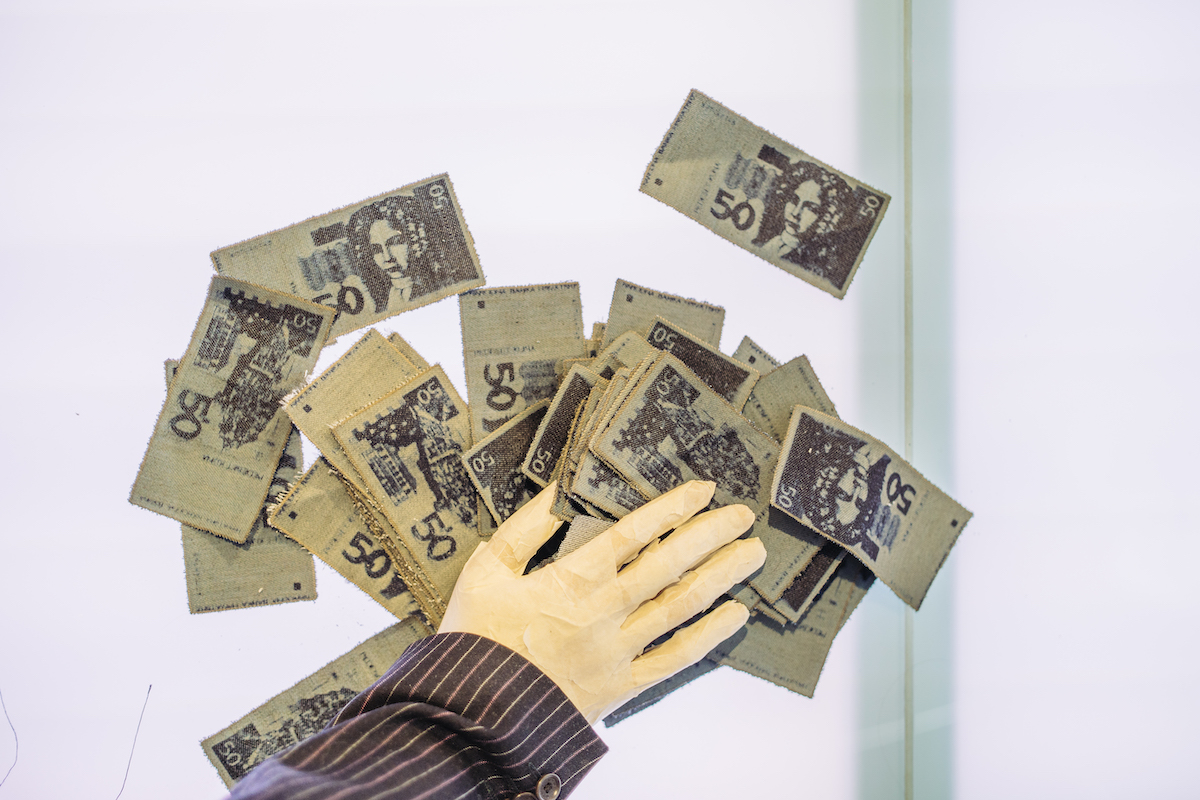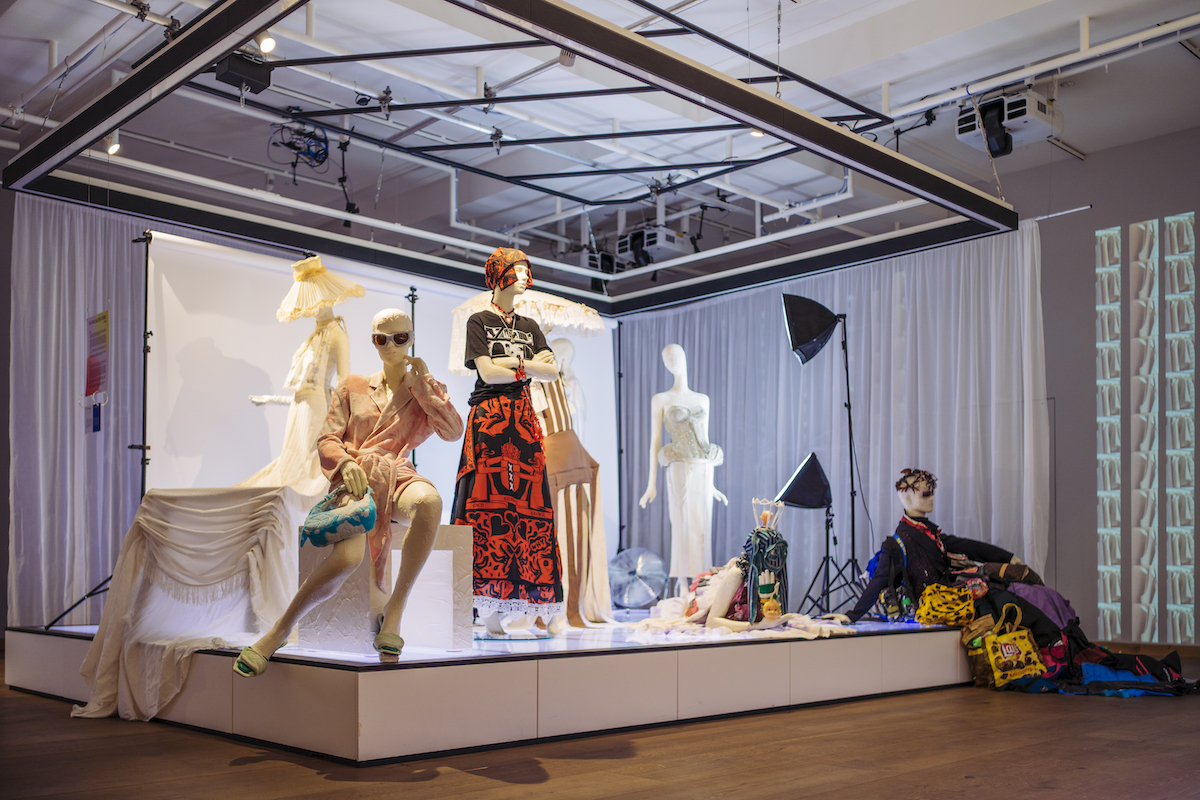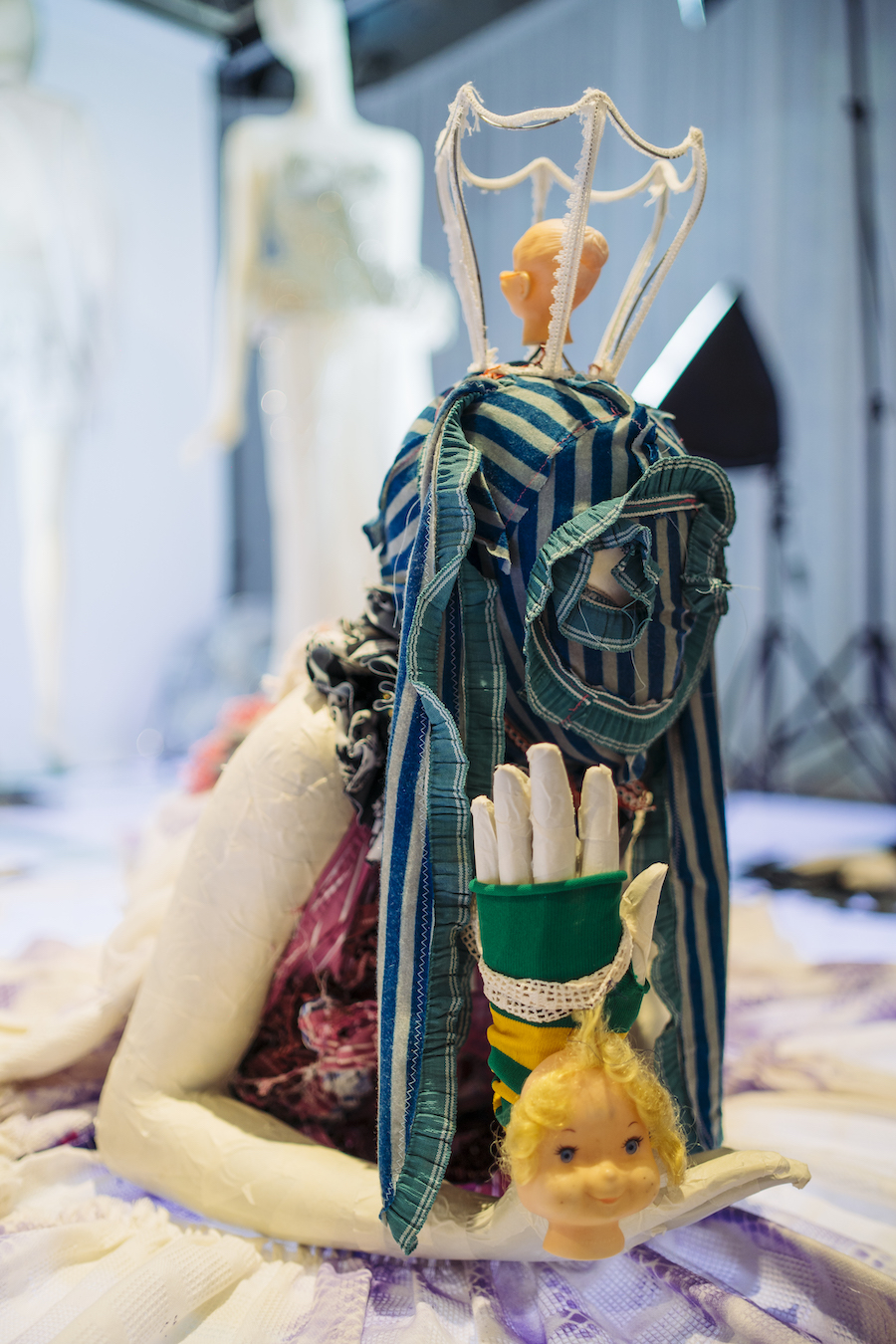A vibrant community

Meet the Patchwork Family, a dynamic fashion design collective that transcends the traditional boundaries in the industry. The Patchwork Family represents a vibrant community of recent graduates brought together by their dedication to each other’s creative journeys and upcycling. Their mission is clear: to foster accessibility and opportunities for emerging creatives in the fashion industry. Their most recent endeavor? Translating their work into an installation for the latest Fashion For Good exhibition “What Goes Around Comes Around.” Each signature design, frozen mid-performance, offers an intimate look into the details of the upcycled garments – a perspective we often lose in the whirlwind of a runway. We got the chance to talk to two members from the family, Marco Blažević and Meike van Lelyveld, so join us as we dive into this installation, The Patchwork Family’s story, and what its like to feel like a rockstar.
Can you guys take me back to the beginning and walk me through how the collection was conceived and started and all that?
Meike: Well, I think it was originally Marco’s brainchild!
Marco: Yeah, it was my brainchild haha. When we graduated from ArtEZ, we were all one friend group in the class graduating during corona times. It was a super tight experience with our friendship group because our teachers didn’t come in a lot, so we discovered how much we could learn from each other. We also just got out of internships, having experience of the real fashion world, and we were like, okay, this is a lot of fun but the real industry is a bit questionable maybe haha. If you also look at most junior designer positions in the industry, you don’t make that much money. We were disenchanted by the industry, realizing that it’s not actually that cool to work for those kinds of brands. We can just as well do our own thing, and worst-case work in the supermarket, where you’ll probably earn more money than a junior design position haha.
You’re not wrong haha.
Marco: We started from there: as a friend group that wanted to stay together and help each other. We were also really overwhelmed; we wanted to start our own brand and we had this huge creative idea of how to do it, but we had no clue about the business side of things as no one teaches you this when you’re in the academy. There was a lot of learning by doing, and helping each other out. Sharing a lot of stuff that is annoying to do for everyone.
Meike: Yeah, and I think what was really valuable is that during Covid, we really learned from each other and realized that we all had our own strengths. So, we became each other’s teachers in a sense, and that if we worked together we can focus on all the things we are all individually good at and have other people in the collective help with the stuff we are not so good at. In the end, we can focus and do more of the stuff we love and be stronger through it.
It’s also a brave stance to take though, to say we tried it and we didn’t like it, let’s just do it ourselves together with our friends.
Marco: But I think we could only do it because we did it together. Like for Meike and me having this approach from the beginning, I would never have dared to do it on my own.
Meike: And from the beginning on we wanted to learn a lot, so if it fails terribly then we still had a blast and we learned. So, whatever happened it would never have been a failure which gave us a lot of freedom. People still had jobs and studies on the side, so it was a luxury that we had this to try things out… and so far, it’s been working great.

Yeah! You guys are definitely not failing haha. Can you walk us through the collective’s journey?
Meike: For the first year, when the idea was conceived, we all just gave each other space to figure out what we wanted to do and how we wanted to do it, which is nice because it didn’t give it a lot of pressure. Then In 2021, we started.
Marco: I think the first thing we did was a launch event at the House of Denim in Amsterdam which was all very cute. I think what has helped from the beginning is that we reached out to a lot of mentors and people in the industry which drew in a lot of knowledge and built a nice network. Then there was a networking event where we met the manager of Club Church, who we became really good friends with. We also met the creative director and decided to do a show there in September 2022. That was very crazy because none of us had done performances before. Church gave us this very experimental stage and the audience we had was so amazing. I think it was the most important moment that year, everyone still remembers that when we stood on stage afterwards there was like 200 people just screaming at us. We felt like rock stars haha. It was a very wild moment. Then I think because we felt like rock stars we were like ‘let’s go on a tour and do this all over Europe!’ Then in January we did Berlin fashion week, we crashed the Chanel show during Paris fashion week, and we showed at London fashion revolution week in April. Afterwards we were like “let’s be in Amsterdam, focus on the community here that has also been giving us all the motivation to do this.”
Meike: Also, during this time we grew the collective. So, we onboarded a lot of new designers and figured out what works. Because we started as a friend group it was a very informal way of working so we had to figure out how-to onboard people in the right way. We started with 5 and now we are at 11 designers. So we have almost doubled!
And then you showed at Amsterdam Fashion Week right?
Meike: Yeah! It was the first time we did a fashion week on an official schedule. So, it was a moment for us to professionalize. It went amazing and we got a lot of great feedback. And that brought us to Fashion For Good. They came to the show and really loved what we were doing so they invited us to work on the new exhibition. So yeah, that we’ve been working on since then. We are also throwing four more parties for Church this year and we threw a party for Poing Club last week in Rotterdam. It’s been really nice to have these high fashion platforms as well as having performances and parties.
It almost feels natural that once you expand beyond your friendship group that people have different interests and specialties. Whether it be parties to runways. And at the same time when you are engaging in the high-end or classical parts of fashion, you’re coming from a unique angle that makes it your own. It’s really nice and refreshing!
Meike: thank you, we just really want to have a lot of fun doing it. I think it’s refreshing because we don’t have the pressure to do it the right way. In the end, we all just want to have fun and be happy. The stakes are not that high for us. It’s just about what we like.
Marco: Yeah, and I think it’s important that it grows organically from our own interests. Even though it’s very cool to have this connection with Church, it comes from us becoming super close friends with them. It’s like my second home. Nothing happens as a way to get good branding or strategy, it’s about if we think it could be fun or matches our interests.
Meike: Yeah and if we tried to force it, it never really works haha.

Well one strict rule you do have is upcycling. You even say upcycling is the most democratic way to make fashion. Could you elaborate on this?
Marco: On one hand It’s very easy and financially accessible. For example when I made my graduation collection I completely upcycled it. Not necessarily because of an ideology, but just because I was broke and didn’t have any money and upcycling centres are for free for graduates. On the other hand, it’s technically more accessible. Fashion academies are made up of a very white privileged student body due to the fact it Is very expensive. But there’s a lot of, for example, kids starting really young printing t-shirts. Through upcycling like this you can still make very high-quality clothing. And we just believe it is the most sustainable way. I’m not a super big believer in all these circular materials, I think it’s a new reason to keep new production over production ongoing and going.
Meike: And it kinda works in a really nice way in a collective because all these garments already had one or two or three lives, and become storytellers of their own. When using these garments you already have this strong storytelling which is interesting to see with our different designers. So, in that way, it works its way back into the design strategies.
You also say “we don’t believe in competition, we believe in fighting together for our ideals” I think that connects to what you’ve said about upcycling and about how there’s this openness to it. So, out of curiosity, how do you guys see your position in the fashion industry?
Meike: One of the most important things that we want to do is lower the bar of entry into the fashion industry. We want to lift young designers up and give them a platform to do their thing with these sustainable ideas we believe in. I think because we were all kind of scared of this industry when we came out of school. If we can help young designers show new and sustainable ideas then we’ve succeeded. We want to kind of pave the road for upcycling designers and give them a community as well.
Switching gears, focusing on your fashion for good installation. Could you walk us through it?
Meike: So, it’s with seven designers so it’s not the entire collective. We made an installation using manikins and upcycled looks. We wanted these manikins to represent the different muses that we usually have. We don’t really work with super typical models, our models have great personalities. They are performers, artists, friends, or just part of our community. So we wanted to have that reflected in the installation as well.
Marco: We believe a lot in the quality of our stuff, but the reason why the Church shows are so good is because it’s a combination of the audience and the place and all these things come together to create the spectacle. And I think if you don’t have the screaming audience and the lights…
Meike: And smoke machines haha.
Marco: I think we really wanted to have this uncuratedness in the museum, how do you bring designers together in one thing. But how do you balance creative freedom? This was the first time we did that in a museum, and I think this guided a lot of what we did.
Obviously, each look is made by a different artist, so do they exist in their own universe, or is there one patchwork universe that you all create in.
Marco: We don’t create for a universe but I think we come together in one universe. I think it’s where the patchwork family comes from. It comes from the sociological term, like former families coming together. Our events are like a little family dinner, like twisted Christmas haha. People come and bring their stuff and we arrange it together. We all live in one universe while also having our little universes.

What inspires your installation as a whole, particularly, the frozen models in motion?
Marco: We have this set up of a glossy photo shoot. I think the generation that started Patchwork is influenced by the 2000s view of fashion; John Galliano is still our god in a way. We always try to think about how to bring glossiness, spectacle, and entertainment to sustainability. But I don’t think people talk about suitability when they talk about Patchwork because it’s a given thing. Usually, with a show, we give this entertainment dimension and now it’s like a 2000s glossy photoshoot.
Meike: Also to give all these different looks different characters. We are all different people and our work is very different. So we wanted the dolls to reflect that, as they have these personalities that really tie in with the design and give it that extra layer. Our clothes are made to tell a story, that’s why we upcycle and do these crazy shows.
What an interesting interpretation of your live performances! It’s just like what we were talking about earlier, about working across various different realms like runways or parties. You can now add installations to how the collective translates across spatial mediums!
Meike: Thank you!
Lastly, what kind of tips or advice can you give to up-and-coming designers who are looking to make an impact and push the fashion industry forward?
Meike: First of all, email us!! Haha. I think it sounds a bit lame but trust your intuition and work with people you really trust, and if you have fun doing it then it can’t really go wrong.
Marco: and also reach out to people. I think academia nurtures a lot of egos, and contributes to burnout in a lot of ways. So, reach out for help! I think there’s a lot of people trying to do the same thing. We are all scared before graduating of this toxic fashion industry, but our experience the last three years has really not been like that. We’ve met some great and friendly people.
Meike: Yeah, I think it’s a bit of an urban myth, it seems like a scary industry but there’s also a lot of people that want to help and learn from each other.
Like you guys!
Meike: Exactly haha!”
Words by Ella Paritsky
Images courtesy of The Patchwork Family
Notifications